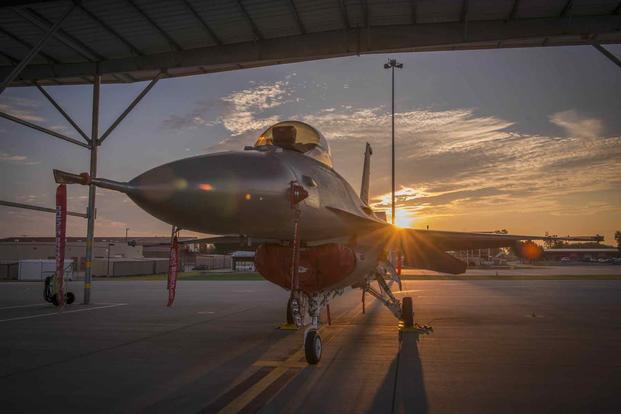An F-16 Fighting Falcon pilot did an unauthorized intercept of a civilian plane before losing control of his fighter jet after hitting the wrong switch and crashing in rural Louisiana this past spring, a new report from the Air Force's Aircraft Accident Investigation Board revealed.
Alexander Drummond, a captain in the Oklahoma Air National Guard who piloted the F-16, safely ejected prior to the March 23 crash. The pilot was publicly identified as the son of Gentner Drummond, an Air Force veteran who was elected as the Republican attorney general of Oklahoma last month, Military.com previously reported.
The Accident Investigation Board's report did not address the pilot by name. The report, made public for the first time last week, said the F-16 crash resulted in a "total loss valued at $26,950,985."
Read Next: The Air Force Reveals New B-21 Bomber, Keeping the Pilot for Now
The incident took place during a training exercise March 23 when two F-16s departed Ellington Field Joint Reserve Base, Texas. During their mission, the duo encountered a civilian aircraft in a holding pattern at Beauregard Regional Airport in Louisiana.
The Guard pilots decided to do a visual identification intercept to identify the tail number of the plane but did not contact the pilot of the civilian aircraft or air traffic control.
The accident report found that the pilot of the jet that crashed hit the wrong switch on his aircraft shortly after the maneuver, causing the fighter to start dropping toward the ground.
When the F-16 pilot completed the intercept by reading the last digit of the civilian aircraft's tail number and was climbing in altitude, he attempted to raise the trailing edge flaps on the jet by flipping the Alternate Flaps switch.
But the pilot selected the Digital Backup switch instead, causing the flaps to retract. That "created a momentary loss of lift" that "caused the aircraft to shudder," and the pilot "incorrectly assessed that the aircraft had departed controlled flight," the report detailed.
Just four seconds after activating the wrong switch, the pilot ejected from the F-16. He made a bailout call prior to ejection, but "that radio transmission was not heard" by the pilot of the other F-16 or nearby agencies. He landed in a tree, disconnected his parachute and then used his personal cell phone to call squadron operations.
C Company, 1st Battalion, 5th Aviation Regiment, a Black Hawk helicopter unit supporting
the Joint Readiness Training Center and the United States Army Garrison at nearby Fort Polk, Louisiana, was tasked with retrieving the pilot. A medic rappelled from the helicopter, examined the F-16 pilot, hoisted him back aboard the Black Hawk and transported him to Bayne-Jones Army Community Hospital at Fort Polk.
In the report, investigators cited a "lack of flight leadership and lack of flight discipline, in the [lead pilot] and the [mishap pilot's] violation of various training rules, including intercepting a non-participating [civilian] aircraft, and incorrectly handling the F-16 in a low speed and low altitude environment," as contributing factors in the crash.
Since 1975, the F-16 has had a total of 383 Class A mishaps -- the classification the military uses for its most deadly and most expensive crashes. In nearly 50 years, 88 pilots have died in the fighter jet, according to data from the Air Force Safety Center.
-- Thomas Novelly can be reached at thomas.novelly@military.com. Follow him on Twitter @TomNovelly.
Related: F-16 Fighter Jet Flown by Oklahoma AG Candidate's Son Crashes in Louisiana; Pilot Ejects Safely











